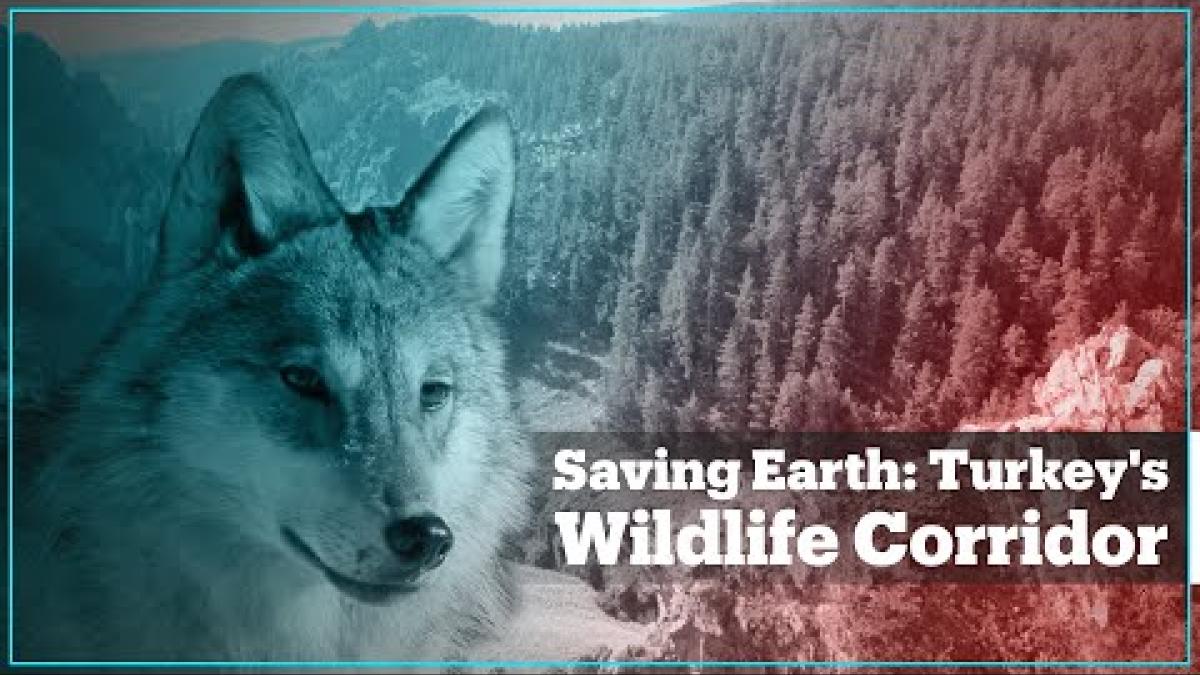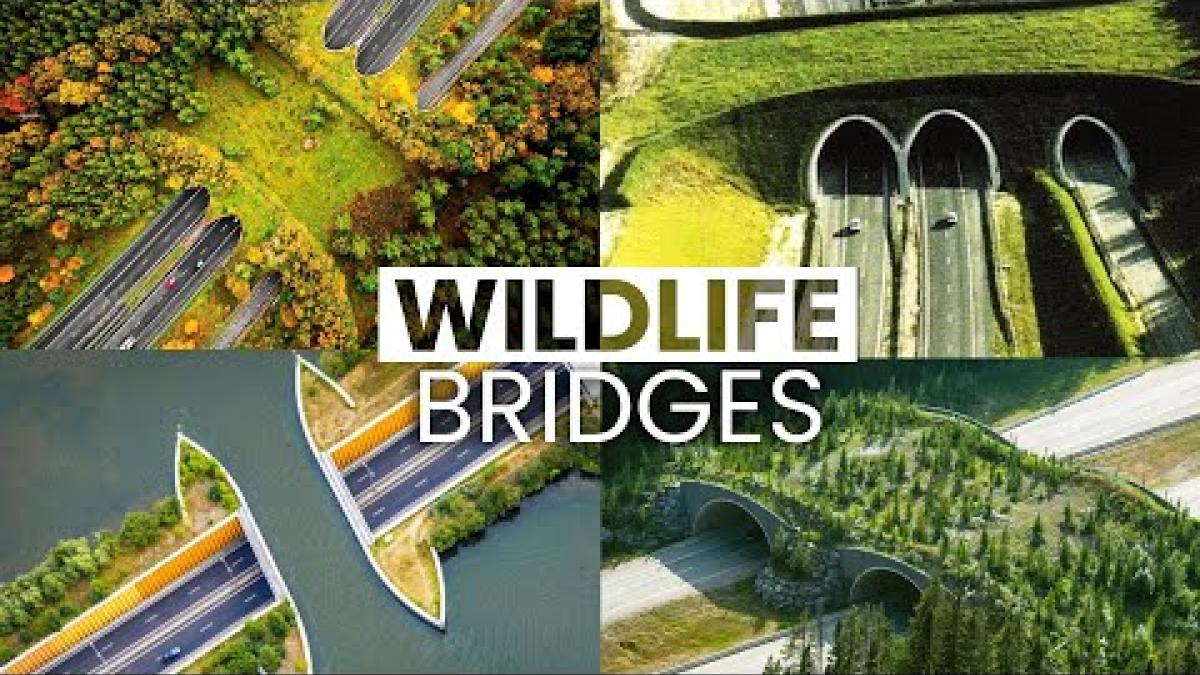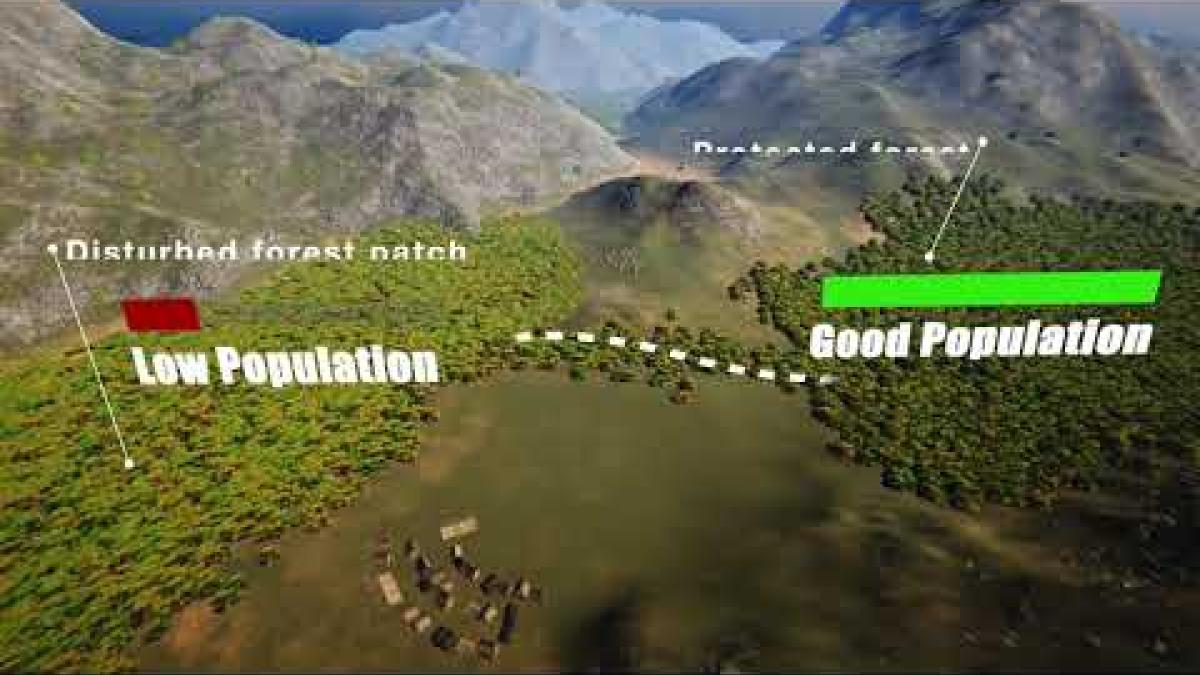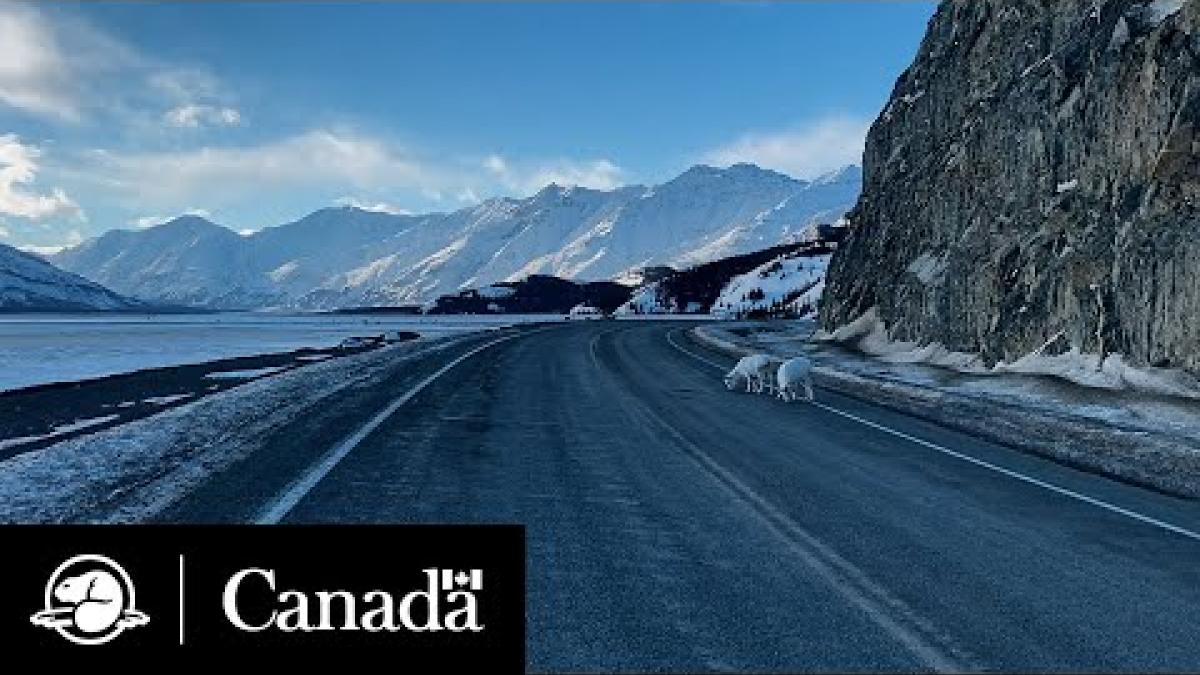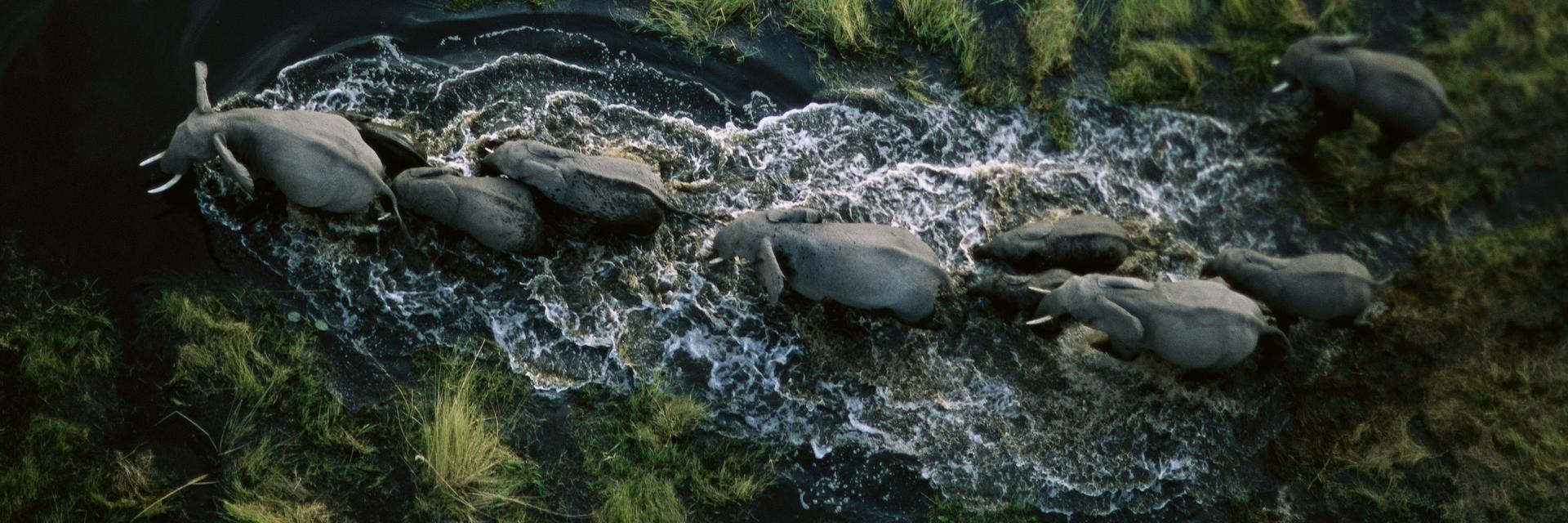
A family of elephants returning to dry brushland.
Credit: George SteinmetzWildlife Corridors
Establish and maintain wildlife corridors on land, water, and in the air to protect wildlife, reconnect fragmented habitats, and help animals adapt to climate change.
Wildlife corridors are pathways of land, water, and air that serve as natural highways for animals. Corridors vary in size and can span thousands of miles. They are crucial for the survival of many species, including the Florida panther, whose range can extend up to two hundred miles, and the globe skimmer dragonfly, which migrates across the Indian Ocean. However, humans have disrupted many of these age-old natural highways with roads, agriculture, and development. This fragmentation undermines ecosystem integrity and prevents animal migration in response to climate stress. Existing corridors need to be protected, old ones restored, and new corridors established in order to protect species, rewild ecosystems, restore degraded land, and support local livelihoods. Corridors are highly compatible with regenerative agriculture, such as agroforestry, and can be expanded with economic incentives, collaborative action, and legal protection.
Action Items
Individuals
Learn about what wildlife corridors are and why they are important. Wildlife corridors are crucial for habitat connectivity efforts, which aim to reconnect habitats that have been fragmented by human activity. Historically, areas such as national parks were established to protect critical habitat, but they did little to connect larger areas that many species depend on. Today, wildlife habitats are becoming increasingly isolated, and species ranges are shifting due to climate change. Marine and aerial corridors are also often disrupted by human activities. By reconnecting larger habitats, corridors create a number of benefits:
- Corridors give species room to move naturally. Wolves use corridors as a connection between hunting areas and dens. Bees and hummingbirds travel along vegetated corridors every day to find flowers to feast on. Elk, deer, pronghorn, and moose in North America travel long distances on their migrations, as do wildebeests, zebras, and elephants in Africa.
- Mating is facilitated by wildlife corridors. Corridors provide a means for many migratory species, including salmon and sea turtles, to mate in distant areas. This prevents inbreeding and reduces genetic diversity that can occur in isolated populations. This is especially important for apex and imperiled species (see Beavers Nexus and Keystone Species Nexus).
- Corridors enable seed dispersal and pollination. Oilbirds in South America have been found to carry large seeds to a distance of between six and thirty miles away. Some birds even transport seeds attached to their feathers or in their stomachs across continents.
- Local economies can be supported by corridor projects. Many corridor projects involve conservation on agricultural land that can serve to benefit local economies through incentives like payments for conservation easements (see more below in Governance) and ecotourism.
- Corridors help avoid human-animal conflicts. As human settlements expand and wildlife habitats shrink, conflicts between migrating animals and humans have risen. Corridors help by providing safe paths for animals to travel.
- Corridor projects can bridge conflicts between agencies, NGOs, and private landowners. These groups can have competing values when it comes to wildlife protection. Implementing corridors can reduce conflicts. The collaboration on pronghorn corridors in Montana is an example.
- Wildlife corridors support degraded land restoration. The on-the-ground work in corridor projects commonly involves restorative techniques that can bring degraded ecosystems back to life, such as by planting trees or reshaping stream banks (see Degraded Land Restoration Nexus).
- Corridors assist in mitigating and adapting to climate change. Wildlife corridors allow species to migrate in response to climate change stressors (see more in Groups: Scientists below).
Explore wildlife corridor projects being executed around the world. A recent study found that more than 65 percent of wildlife corridors where animal movement is most concentrated are unprotected. But the push to protect and establish more wildlife corridors is picking up speed:
- The Florida Wildlife Corridor is a project that encompasses nearly 17.7 million acres in the state. The state Legislature recently authorized $18 million to expand the corridor program.
- Oslo’s Bee Highway is protecting the bee population by replacing meadows and lawns with local grasses and wildflowers.
- The Sredneussuriisky Wildlife Corridor links critical Amur tiger habitat and nesting grounds for Oriental storks between Russia and China.
- The Path of the Pronghorn became the first federally designated migration corridor in the United States in 2008 that uses wildlife-friendly fencing.
- The Kaziranga-Karbi Anglong Corridor in India allows wildlife to migrate in and out of Kaziranga National Park while also working with local communities to advocate for agroforestry.
- The Mesoamerican Biological Corridor acts as a natural bridge between North and South America, with a focus on Indigenous land rights.
- The East Atlantic Flyway is a migratory route for millions of birds stretching from summer breeding grounds in the Arctic to wintering areas in southern Africa. The Wadden Sea Flyway Initiative advocates for wetland protection along this corridor.
- The Eastern Tropical Pacific Marine Corridor is an initiative that will link several existing marine protected areas in the Pacific Ocean.
- Wildlife crossings can be viewed as small-scale wildlife corridors. Some famous wildlife crossings can be found in Canada’s Banff National Park; among others are the red crab bridges on Christmas Island in Australia and turtle tunnels in Japan (see more below in Groups: Urban Planners).
- Seven pilot projects for ecological corridors in Canada.
Create and advocate for local wildlife corridors. Smaller corridor projects can be executed at the neighborhood level, and there are ways that individuals can advocate for corridors big and small:
- Start a neighborhood wildlife corridor. Wildlife corridors as little as twenty-five yards in width create improvements in local biodiversity, especially for pollinators (see more in Rewilding Nexus and Pollinators Nexus). This can be done by establishing gardens, ponds, and meadows filled with native flowers, grasses, and trees. Froglife in the UK organizes such a project.
- Get involved with an existing grassroots effort. The Live Wildly Foundation is actively seeking individuals to join its work in protecting the Florida Wildlife Corridor. The Couchiching Conservancy’s Corridors Campaign in Ontario also have volunteer and donation opportunities (see more organizations below in Key Players: Organizations).
- Call on government officials to support corridor projects. Citizens can advocate through public comments or by speaking up at meetings. Recent regulations open to public comment include Los Angeles’ draft Wildlife Corridor Ordinance and the federal big game corridor policy in Colorado.
Groups
Rural Landowners
Host a wildlife corridor project. Land clearing for agriculture could reduce the habitats of around 90 percent of land animals globally by 2050. There are a number of ways this threat can be mitigated (see Agroforestry Nexus and Regenerative Agriculture Nexus). Rural landowners can reduce habitat loss by establishing and maintaining wildlife corridors on their properties:
- Partner with public agencies on corridor projects. A public-private partnership in Borneo is establishing an Orangutan corridor on palm oil plantations on the island. Farm Bill programs in Wyoming are safeguarding migratory big game populations.
- Implement practices that support corridors. Some best management practices for maintaining corridors on agricultural land include wildlife-friendly fencing (or even virtual fencing) and buffer zones for riparian areas. The afforestation of unused farmland can also be critical, as it is a forest corridor for Brazil’s black lion tamarin (see more in Afforestation Nexus).
- Enter into conservation easements. Conservation easements are agreements between a landowner and a land trust or government that permanently limit the use of the land in order to protect conservation values. Landowners often receive tax benefits for entering into easements. One such protected property in Florida borders a highway and connects a unique scrub habitat.
- Coordinate with other rural landowners in the area. Coalitions of rural landowners can ensure that adjacent properties create a contiguous corridor. Several farms in Vermont recently worked together to plant native trees and shrubs along their properties in order to restore a river corridor.
Land Trusts
Include wildlife corridors as a key land management strategy. Land trusts are nonprofit organizations that acquire land and oversee conservation easements for the purpose of preservation. Land trusts can do their part by making wildlife corridors a priority for their projects.
- The Sonoma Land Trust in California has worked to prevent the narrowest point of the Sonoma Valley Wildlife Corridor from closing up by purchasing properties and even funding a mountain lion telemetry study.
- Land trusts should discuss how to protect land for corridors, including whether and how solar and wind farms should be sited on these properties (see Solar Nexus and Wind Nexus).
- Land trusts should focus on the issue of local land rights. Aboriginal land trusts in Australia are an example of land rights navigated successfully, where the land is legally granted to an Aboriginal community.
Wildlife Agencies
Meaningfully involve other stakeholders on wildlife corridor projects. Lands needed for corridor projects are often multijurisdictional, requiring buy-in from private landowners, NGOs, Indigenous peoples, and other stakeholders.
- Solicit members of the public. Get their perspective on potential corridor projects, as was done in Bedford, New York.
- Support active engagement of local communities in corridor design. Indigenous communities in the Democratic Republic of the Congo were engaged to conduct biodiversity surveys and land-use mapping for a corridor project on their land.
- Host multistakeholder workshops. Participants in a workshop on wildlife migration corridors in the American West included wildlife agencies, transportation departments, agricultural organizations, landowners, conservation nonprofits, and local elected officials.
Urban and Regional Planners
Design effective wildlife crossings. Wildlife crossings can provide valuable habitat connectivity and wildlife escape measures in urban areas. One wildlife crossing across a road can save society up to $443,000 annually through vehicle collision reductions. There are several ways in which wildlife crossing design and implementation can be improved:
- A U.S. Department of Transportation handbook provides guidance on effective crossing design and implementation. The handbook stresses the avoidance of critical habitat by new road building in the first place. Critical habitat designations perturb road construction in these sensitive areas.
- India’s first urban wildlife corridor will consist of a network of wildlife crossings below roads around a wildlife sanctuary frequented by leopards.
- Effective urban corridor design can include large urban green spaces and denser cities that reduce the amount of forest edge habitat (see more in Nature of Cities Nexus).
- The Port Townsend Urban Wildlife Corridor in Washington is an example of a large urban corridor that reconnects wetlands in areas facing development pressure.
- Although wildlife crossings can spread invasive species, this risk can be mitigated by sowing native plants on crossings.
Researchers
Study the climate benefits of wildlife corridors. Wildlife corridors provide a number of ecosystem services. Riparian corridors minimize flooding risks, and corridors in urban areas provide shade that combats the urban heat island effect. A better understanding of the benefits of wildlife corridors as they specifically relate to climate change is needed, particularly in areas such as:
- The carbon sequestration potential of wildlife corridors. Mature forests tend to hold the most carbon, though many animals, such as the Canada lynx, rely on younger forests to hunt. While live oaks planted in the Florida Wildlife Corridor sequester more carbon than cabbage palms, palms produce berries eaten by many animals. These tradeoffs must be analyzed further in corridor projects.
- The interplay of wildlife corridors and assisted migration. Assisted migration occurs when humans help animals relocate to more suitable habitats in response to climate stressors, and wildlife corridors may play a role in this effort. For instance, existing corridors may need to be adjusted to provide paths to areas previously uninhabited by the target species. GPS collars may be used to understand new animal movement paths.
- The role of climate change refugia in corridor projects. Climate change refugia are ecological areas that persist despite changes in the climate of the surrounding landscape. These refugia provide places where wildlife, such as the snow leopard, can shelter despite warming temperatures and extreme weather caused by climate change. Wildlife corridors may need to ensure that such refuges remain connected.
- Wildlife corridor approaches in the ocean. Ocean creatures face unique challenges from climate change, such as ice melt affecting currents and ocean acidification. Further study is needed to understand how corridor approaches that apply to a wide variety of biotopes in the ocean can be formed. Protecting Blue Corridors is starting to do this by mapping the migratory routes of whales.
Governance
Enact economic incentives that make wildlife corridor projects viable on private lands. Corridor projects on private lands are crucial, especially given that around half of all threatened and endangered species have at least 80 percent of their habitat on private properties. Economic incentives that make corridor projects on private lands worthwhile to landowners include:
- Conservation stewardship contracts. Through these contracts, landowners agree to employ conservation measures on their properties in exchange for benefits such as direct payments or grazing rights. For instance, Indigenous communities in India agreed to observe protocols for the sustainable harvesting of forest products in a tiger reserve. In exchange, these communities are guaranteed premium prices for their products.
- Free technical support. A study in Uruguay found that nonmonetary incentives, such as access to training and technical support, were preferred by landowners over monetary payments to ensure conservation on their lands.
Provide systematic protection to wildlife corridors across political boundaries. Wildlife and its corridors do not recognize political borders between countries and other jurisdictions. There are a number of ways wildlife corridors that cross political borders can be established and protected (see Grasslands Nexus and Marine Protected Areas Nexus):
- Sign and implement intercountry agreements that safeguard corridors. In 2018, Bolivia, Brazil, and Paraguay signed an agreement committing to coordinating strategies to protect the Pantanal, the world’s largest wetland. This area serves as an important component of a large jaguar corridor in South America.
- Partner with organizations that will facilitate international coordination. Peace Parks Foundation helped coordinate the protection of a corridor between South Africa and Mozambique that is used by zebra and wildebeest.
- Strengthen the protection of intercountry flyways. Signed by eighty-two countries, the African-Eurasian Migratory Waterbird Agreement is considered a leading example of a legally binding intercountry flyway protection framework. The agreement mandates wetland conservation and monitoring along the flyway.
- Find alternatives to border walls that may fragment corridors. Defenders of Wildlife has released a series of recommendations for reconnecting wildlife corridors on the U.S.-Mexico border, including opening all gates, turning off lights, reducing noise at the border, and replacing the wall with vehicle barriers designed to allow wildlife to pass.
Collaborate with the local communities whose land is used for corridor projects. In addition to having invaluable local knowledge of wildlife corridors, local communities may ascribe spiritual significance to the animals migrating in these corridors, such as the annual salmon return recognized by tribes in the Pacific Northwest. Meaningful collaboration with local communities on corridor projects involves a number of different policy levers, including:
- Recognition of Indigenous land rights. In Tanzania, the Nature Conservancy helped protect wildlife movement and dispersal areas in part by securing legal rights for more than 680,600 hectares of traditional homelands for hunter-gatherers and pastoralists (see Pastoralism Nexus and Tropical Forests Nexus).
- Legislation that directs resources to corridor projects on tribal land. The proposed Tribal Wildlife Corridors Act in the U.S. would establish a process for identifying tribal wildlife corridors and authorize $50 million per year to ensure that Tribal Nations have the resources to implement and maintain corridors on their lands.
Key Players
Organizations
African Wildlife Foundation (Kenya) envisions an Africa where sustainable development includes thriving wildlife and wild lands as a cultural and economic asset for future generations.
Associação Mico-Leão-Dourado (Brazil) promotes the conservation of the Atlantic Forest in the coastal lowlands of the state of Rio de Janeiro.
Defenders of Wildlife (North America) is dedicated to the protection of all native animals and plants in their natural communities.
Florida Wildlife Corridor Foundation (U.S.) champions a collaborative campaign to permanently connect, protect, and restore the Florida Wildlife Corridor.
Instituto Araguaia (Brazil) protects the biodiversity of the Araguaia River basin and its ecological processes.
National Audubon Society (U.S.) protects birds and the places they need, today and tomorrow, throughout the Americas using science, advocacy, education, and on-the-ground conservation.
National Parks Conservation Association (U.S.) is protecting and enhancing America's National Park System for present and future generations.
The Nature Conservancy (Global) is advancing effective, lasting conservation in more than 80 countries and territories.
Rainforest Trust (U.S.) saves endangered wildlife and protects our planet by creating rainforest reserves through partnerships, community engagement and donor support.
Rewilding Europe (Netherlands) has a mission to demonstrate the benefits of wilder nature through the rewilding of diverse European landscapes.
Wildlands Network (North America) uses science-based research and innovative policy to reconnect and restore Wildways, helping prevent biodiversity loss and promoting climate resilient landscapes.
Wildlife Conservation Trust (India) was founded to safeguard India’s life-giving ecosystems holistically and sustainably.
Humane Society International (Australia) builds an ecologically sustainable and humane world for all animals.
Wild Tomorrow Fund (U.S. / UK / South Africa) works to protect, restore, and rewild habitats.
The Wildlife Society (North America) empowers wildlife professionals to advance conservation through science, community, and professional excellence.
World Wildlife Fund (Global) works to sustain the natural world for the benefit of people and wildlife, collaborating with local and global partners in nearly 100 countries.
Learn
Watch
Conservation and Restoration of Wildlife Corridors and Habitat Connectivity by US Department of the Interior (42 mins.)
Our Amazing Grasslands—Schmidt Family by USDA NRCS South Dakota (5 mins.)
Saving the Florida Wildlife Corridor by National Geographic (10 mins.)
I-90 Snoqualmie Pass East: Critter Crossings in the Cascades by WSDOT (20 mins.)
Read
How to Conserve Wildlife Migrations in the American West by Pew Charitable Trusts
Supernavigators: Exploring the Wonders of How Animals Find Their Way by David Barrie / The Experiment
What Are Wildlife Corridors? by the Australian Government
Wilder: How Rewilding Is Transforming Conservation and Changing the World by Millie Kerr / Bloomsbury Sigma
Wildlife Connectivity: Fundamentals for Conservation Action by the Center for Large Landscape Conservation
"10 Important Wildlife Corridors" by Josh Lew / Treehugger
"Safe Passages" by Jeremy Austin and Lace Thorberg / Central Oregon Landwatch
"Animal Crossing: Reconnecting North America’s Most Important Wildlife Corridor" by Brian Banks / Canadian Geographic
"As Banff’s Famed Wildlife Overpasses Turn 20, the World Looks to Canada for Conservation Inspiration" by Gloria Dickie / Canadian Geographic
"How Wildlife Corridors Can Reconnect Canada's Fractured Habitats" by Nathan Howes / The Weather Network
Listen
Creating Wildlife Corridors by The Wildlife Gardener Podcast (19 mins.)
Rewilding Earth Podcast by The Rewilding Institute
Wildlife Corridors by the Great Northeast Podcast (31 mins.)
Wildlife Corridors of India by Sustainability Weekly Podcast (22 mins.)
Share this page


